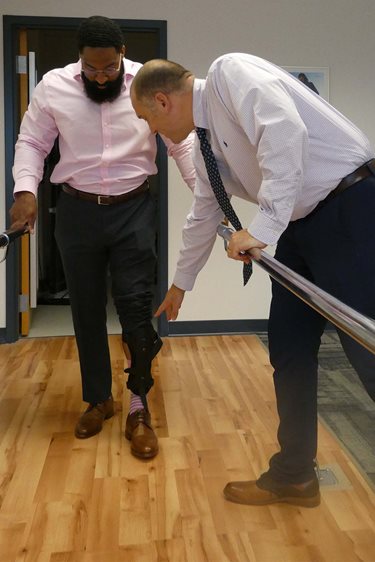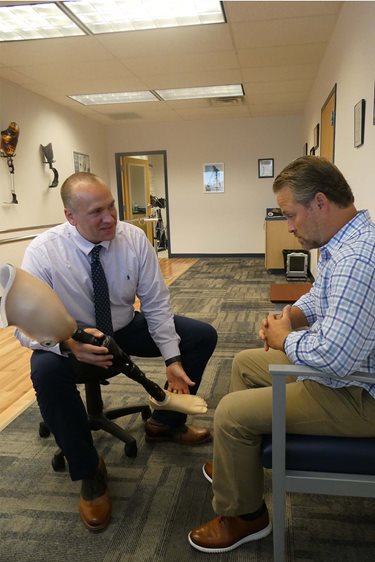A Q&A with O&P program director, Dr. Chad Duncan, about the University’s newest program
As work behind the scenes to launch the new Orthotics and Prosthetics (O&P) program at Salus University continues, we spoke with the O&P program director, J. Chad Duncan, PhD, CRC, CPO, to talk about what prospective students can expect when the program launches in fall 2022.
What is the major difference between orthotics and prosthetics?
When we talk about orthotics, we'll be training students at Salus to make custom orthotics and prosthetics or orthosis and prosthesis, depending on how you use it in a sentence. This is an important delineation because what we do doesn't typically come off the shelf, instead it is custom made for the individual they are seeing. O&P students are highly trained in biomechanics, anatomy and pathologies and with this knowledge they determine the appropriate orthotic management.
 An external prosthesis, not to be confused with an internal prosthesis such as a hip replacement, is an artificial replacement for a missing limb or part of a limb that can help individuals regain independence post amputation or those living with limb loss. We don't do anything internal. We might be involved with the surgery, but we're not performing the surgery. So, we at Salus will focus on the socket technology and design, which is specific to the individual students will be seeing.
An external prosthesis, not to be confused with an internal prosthesis such as a hip replacement, is an artificial replacement for a missing limb or part of a limb that can help individuals regain independence post amputation or those living with limb loss. We don't do anything internal. We might be involved with the surgery, but we're not performing the surgery. So, we at Salus will focus on the socket technology and design, which is specific to the individual students will be seeing.
The types of prosthetics we see on TV show amputees running and doing different physical activities they wouldn’t be able to perform without the prosthetic. Examples include the 3D printed Hero Arm, the J-shaped Flex Foot and microprocessor knees. The Paralympics recently occurred in Japan and they promoted the Hero Arm a lot because it’s more visual and active. And, that’s how prosthetics can be a hit in mainstream media.
In orthotics terms, the name tells us what it supports. An ankle foot orthosis, or AFO for example, supports the ankle and foot of stroke survivors when their foot drops or drags on the ground. The AFO keeps the foot up, so they're not falling or dragging their ankle. Overall, an AFO is a device that is used to control instabilities in the lower limb by maintaining proper alignment and controlling motion. The goal is to provide back stability and mobility to the patient.
If you think about orthosis or an orthotic, an orthotic gives structure to the limb segment. A permanent type would be a cast, for example. A cast could be a type of orthosis because it's there to support a bone when it's broken. There's certain orthosis that would do the same. In prosthetics, picture a break dancer using a microprocessor knee. It wouldn't work if the prosthetist, who made the socket that attaches to the dancer’s body, didn't fit it correctly. And, that's what we're going to be doing at Salus, learning how to make the sockets appropriately.
What type of students will be drawn to the University’s new O&P program?
We're open to any student who meets all the prerequisites and has at least shadowed in the profession because a lot of students don't realize how hands-on and clinically oriented the University’s O&P program will be.
Engineering students with focus areas in biomedical, mechanical and industrial engineering will be drawn to the program. But we want a variety of students at Salus. The O&P program will also appeal to students who earned their undergraduate degrees in psychology, kinesiology, sports medicine, exercise science, and rehabilitation services.
 What’s unique about the O&P program at Salus in comparison to programs offered at other institutions?
What’s unique about the O&P program at Salus in comparison to programs offered at other institutions?
Our O&P program will be different than most of the programs in the U.S. because it is being built using cultural humility as a central theme, treating people as individuals, and understanding their support networks and being life-long learners of others. As the profession changes, we must lead with diversity, equity and inclusion. When I went to school, it was roughly 85 percent male and 15 percent female applying. Today, it's 85 percent female and 15 percent male typically applying. So, the shift has brought a lot of diversity into the profession.
We really want students from all backgrounds to feel they belong at Salus and belong in the O&P profession. That’s where the theme of cultural humility is being woven throughout the program. And, there is going to be a specialty track in that particular area for students who are interested, and they'll be connected with experts in the discipline and profession.
The other unique piece is that the residency will be built into the program. Students will not be responsible for finding their own residencies. Students will have three, six-month rotations that are specific to the profession. The format is extremely beneficial to students because it keeps them with a company longer, and that really gauges developmental progress. Also, from a development perspective, if an issue is occurring with a student’s progress, we can do remediation easier when they're with an employer longer or if it's just not a good fit, we can transition the student to somewhere new.
Where can O&P students expect to do their residencies?
Students could work at a large company such as Hanger or local companies such as Lawall Prosthetics & Orthotics or Ability Prosthetics & Orthotics. Another company is called Ossurs, which is an Icelandic company based in patient care as well. Some larger clinics we’re trying to partner with include Shirley Ryan AbilityLab in Chicago and the University of Michigan program.
There’s also VA based residencies available. Luckily, we're closer to Washington, D.C., where great residency sites with the VA exist. And, then there are a few hospitals that have residency-based experiences.
Our students, if we strike up a contract, can go anywhere.